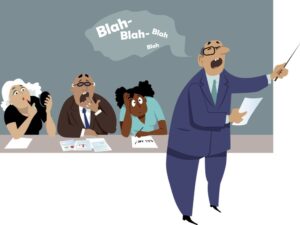Comms Etymology: The finer points of punctuation
The poignant origins of periods, commas and beyond.

Communicators are the reigning monarchs of wordsmithing, and their words are their tools and materials for constructing compelling, persuasive, authentic and authoritative messaging that makes critical connections, reflects their organization’s mission and values, and brings its voice to life.
Punctuation, then, serves as the nuts, bolts, nails and screws that form the structural support of organizational purpose and expression.
In the next few editions of Comms Etymology, we wordwrights will explore how the punctuation we use in our everyday writing came to be, starting with the most used symbols.
Punctuation Etymology Basics
The word “punctuation” is from the Latin pungere, meaning “to prick or pierce.” It’s related to words such as “pungent” and “poignant” — words for things that pack a metaphorical punch (appropriate given that “punch” is also a relative). This word originally referred to the practice of psalm-pointing. The dots and marks used to notate psalms so that they could be sung or chanted inspired many of the symbols we use to punctuate writing today.
- Period (.) comes from the Latin periodus, meaning a period of time. But it could also mean “a complete sentence,” suggesting a segment or time span of speech or writing. Over time, a period became the mark that signified when a complete sentence had come to an end. (The sense of a “time span” is also why both eras and menstruation are called “periods.”)
- Comma (,) is originally from the Greek word komma, literally meaning “cut off,” though it was also used to mean “a clause in a sentence or a line of poetry.” So a comma indicates a pause or literally “a cutting off” of a phrase that is part of a whole sentence or a line of verse.
- The name of an exclamation point (!) is self-explanatory — it’s a mark that exclaims. It’s from the Latin exclamare meaning “to cry out.” But what you may not know is that for a time in the mid-1800s, exclamation points were sometimes known as “shriek-marks.”
- The question mark (?) is an evolution of the 8th-century mark called the punctus interrogativus, which is described as resembling “a lightning flash, striking from right to left.”
Less Common Punctuation
Ampersand (&)
The symbol we call an “ampersand” was originally a Roman shorthand version of the Latin word et, meaning “and,” with the letters E and T stylized into a ligature, or a typographic combination of letters. Graffiti including the symbol can still be found around the city of Pompeii.
Ligatures were common in Roman cursive, and some persisted into medieval writing styles including the Carolingian minuscule, the standard calligraphic style of the era in Europe. Another that has persisted, even today, is æ.
The word ampersand arose in the mid-1800s and is a contraction of the phrase “and per se and,” which means “(the character) ‘&’ by itself is ‘and.’” An earlier contraction, recorded in the 1700s, was ampassy.
The name of this mark is rather long because the symbol was also used as a part of other shorthand.
For example, an early symbol for et cetera, which is Latin for “and the others,” was an ampersand followed by the letter c. So, the word ampersand just means “the ligature symbol for and or et by itself” without anything else attached.
Pilcrow
If you turn on annotations in your Word or Google document, you’ll see this symbol (¶), called a pilcrow, marking paragraph breaks.
This symbol emerged in Medieval manuscripts: Scribes would mark a break in writing by drawing a little mark in the margin that looked like an embellished version of the mark.
It also inspired the word “paragraph,” literally means “to write beside.” The sense shifted to the actual sections, rather than the mark, in the 17th century as printing technology and notations advanced.
The word “pilcrow,” in turn, is a mangled variation of the word “paragraph.” In Old French, pelagraphe was a variation of the word paragrafe, and this variation was misunderstood in English as pilcraft, which itself was corrupted to “pilcrow,” the word for that same symbol denoting paragraph breaks in modern word processors (and their predecessors).
Interrobang
And now we come to everyone’s favorite mark, albeit one that’s rarely used. The interrobang (‽) was proposed by ad agency owner Martin K. Speckter in 1962 as a tool for copywriters to convey a surprised rhetorical question. Interrobang is a portmanteau of “interrogative,” and “Bang,” which has been printer or programmer jargon for an exclamation point since at least the 1950s.
Stay tuned for the next edition of Comms Etymology for an additional dive into punctuation. In the meantime, hone your writing skills by joining Ragan’s Writing Center.
Jess Zafarris is an author, content director, editor, journalist, social media engagement strategist and creator. Her 13 years of experience in this space have included such roles as the Director of Content at Ragan Communications, Audience Engagement Director at Adweek, and Content Strategist and Digital Content Director for Writer’s Digest and Script Mag. She moderated and emceed at events including Social Media Week and Brandweek, and presented at the Writer’s Digest Conference and State of Social. She is also the author of the etymology books “Words from Hell” and “Once Upon a Word” and an educational social media creator who speaks and creates entertaining content about word origins.








Hi Jess. Great article. Thanks. Learned a lot.
Question for you. In you paragraph:
The word ampersand arose in the mid-1800s and is a contraction of the phrase “and per se and,” which means “(the character) ‘&’ by itself is ‘and’.” An earlier contraction, recorded in the 1700s, was ampassy.
It looks like the period after the last ‘and’ falls in-between the single quote mark and the double quote mark. According to https://www.thesaurus.com/e/grammar/does-punctuation-go-inside-or-outside-quotation-marks/
✅ Correct: The witness said, “I heard the man say, ‘Don’t move.’”
❌ Incorrect: The witness said, “I heard the man say, ‘Don’t move’.”
Guidance?
You’re correct, Shane! Great catch. We’ll get that updated.
Eek. Having a typo in my post = #embarassing.
Should say “In your paragraph” not “In you paragraph.”
If there was a flushed-face emoji available I would use it.
Keep up the great work, Jess!